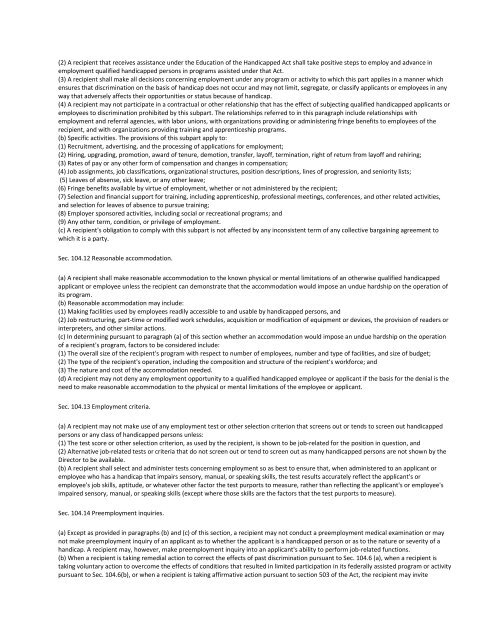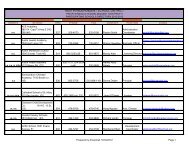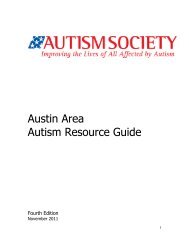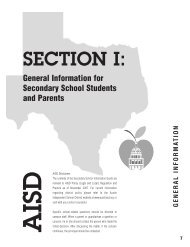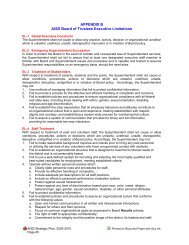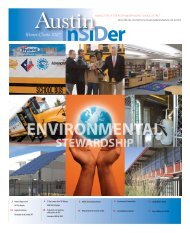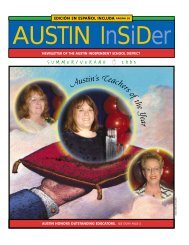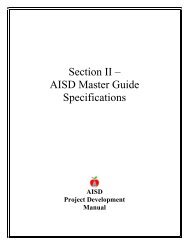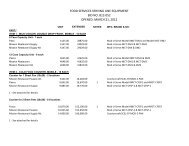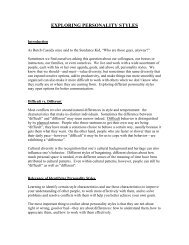that resulted in limited participation in the recipient's program or activity by qualified handicapped persons.(c) Self-evaluation. (1) A recipient shall, within one year of the effective date of this part:(i) Evaluate, with the assistance of interested persons, including handicapped persons or organizations representing handicapped persons,its current policies and practices and the effects thereof that do not or may not meet the requirements of this part;(ii) Modify, after consultation with interested persons, including handicapped persons or organizations representing handicapped persons,any policies and practices that do not meet the requirements of this part; and(iii) Take, after consultation with interested persons, including handicapped persons or organizations representing handicapped persons,appropriate remedial steps to eliminate the effects of any discrimination that resulted from adherence to these policies and practices.(2) A recipient that employs fifteen or more persons shall, for at least three years following completion of the evaluation required underparagraph (c)(1) of this section, maintain on file, make available for public inspection, and provide to the Assistant Secretary upon request:(i) A list of the interested persons consulted,(ii) A description of areas examined and any problems identified, and(iii) A description of any modifications made and of any remedial steps taken.Sec. 104.7 Designation of responsible employee and adoption of grievance procedures.(a) Designation of responsible employee. A recipient that employs fifteen or more persons shall designate at least one person to coordinateits efforts to comply with this part.(b) Adoption of grievance procedures. A recipient that employs fifteen or more persons shall adopt grievance procedures that incorporateappropriate due process standards and that provide for the prompt and equitable resolution of complaints alleging any action prohibited bythis part. Such procedures need not be established with respect to complaints from applicants for employment or from applicants foradmission to postsecondary educational institutions.Sec. 104.8 Notice.(a) A recipient that employs fifteen or more persons shall take appropriate initial and continuing steps to notify participants, beneficiaries,applicants, and employees, including those with impaired vision or hearing, and unions or professional organizations holding collectivebargaining or professional agreements with the recipient that it does not discriminate on the basis of handicap in violation of section 504and this part. The notification shall state, where appropriate, that the recipient does not discriminate in admission or access to, or treatmentor employment in, its programs and activities. The notification shall also include an identification of the responsible employee designatedpursuant to Sec. 104.7(a). A recipient shall make the initial notification required by this paragraph within 90 days of the effective date of thispart. Methods of initial and continuing notification may include the posting of notices, publication in newspapers and magazines, placementof notices in recipients' publication, and distribution of memoranda or other written communications.(b) If a recipient publishes or uses recruitment materials or publications containing general information that it makes available toparticipants, beneficiaries, applicants, or employees, it shall include in those materials or publications a statement of the policy described inparagraph (a) of this section. A recipient may meet the requirement of this paragraph either by including appropriate inserts in existingmaterials and publications or by revising and reprinting the materials and publications.Sec. 104.9 Administrative requirements for small recipients.The Assistant Secretary may require any recipient with fewer than fifteen employees, or any class of such recipients, to comply with Secs.104.7 and 104.8, in whole or in part, when the Assistant Secretary finds a violation of this part or finds that such compliance will notsignificantly impair the ability of the recipient or class of recipients to provide benefits or services.Sec. 104.10 Effect of state or local law or other requirements and effect of employment opportunities.(a) The obligation to comply with this part is not obviated or alleviated by the existence of any state or local law or other requirement that,on the basis of handicap, imposes prohibitions or limits upon the eligibility of qualified handicapped persons to receive services or topractice any occupation or profession.(b) The obligation to comply with this part is not obviated or alleviated because employment opportunities in any occupation or professionare or may be more limited for handicapped persons than for nonhandicapped persons.Subpart B--Employment PracticesSec. 104.11 Discrimination prohibited.(a) General. (1) No qualified handicapped person shall, on the basis of handicap, be subjected to discrimination in employment under anyprogram or activity to which this part applies.
(2) A recipient that receives assistance under the Education of the Handicapped Act shall take positive steps to employ and advance inemployment qualified handicapped persons in programs assisted under that Act.(3) A recipient shall make all decisions concerning employment under any program or activity to which this part applies in a manner whichensures that discrimination on the basis of handicap does not occur and may not limit, segregate, or classify applicants or employees in anyway that adversely affects their opportunities or status because of handicap.(4) A recipient may not participate in a contractual or other relationship that has the effect of subjecting qualified handicapped applicants oremployees to discrimination prohibited by this subpart. The relationships referred to in this paragraph include relationships withemployment and referral agencies, with labor unions, with organizations providing or administering fringe benefits to employees of therecipient, and with organizations providing training and apprenticeship programs.(b) Specific activities. The provisions of this subpart apply to:(1) Recruitment, advertising, and the processing of applications for employment;(2) Hiring, upgrading, promotion, award of tenure, demotion, transfer, layoff, termination, right of return from layoff and rehiring;(3) Rates of pay or any other form of compensation and changes in compensation;(4) Job assignments, job classifications, organizational structures, position descriptions, lines of progression, and seniority lists;(5) Leaves of absense, sick leave, or any other leave;(6) Fringe benefits available by virtue of employment, whether or not administered by the recipient;(7) Selection and financial support for training, including apprenticeship, professional meetings, conferences, and other related activities,and selection for leaves of absence to pursue training;(8) Employer sponsored activities, including social or recreational programs; and(9) Any other term, condition, or privilege of employment.(c) A recipient's obligation to comply with this subpart is not affected by any inconsistent term of any collective bargaining agreement towhich it is a party.Sec. 104.12 Reasonable accommodation.(a) A recipient shall make reasonable accommodation to the known physical or mental limitations of an otherwise qualified handicappedapplicant or employee unless the recipient can demonstrate that the accommodation would impose an undue hardship on the operation ofits program.(b) Reasonable accommodation may include:(1) Making facilities used by employees readily accessible to and usable by handicapped persons, and(2) Job restructuring, part-time or modified work schedules, acquisition or modification of equipment or devices, the provision of readers orinterpreters, and other similar actions.(c) In determining pursuant to paragraph (a) of this section whether an accommodation would impose an undue hardship on the operationof a recipient's program, factors to be considered include:(1) The overall size of the recipient's program with respect to number of employees, number and type of facilities, and size of budget;(2) The type of the recipient's operation, including the composition and structure of the recipient's workforce; and(3) The nature and cost of the accommodation needed.(d) A recipient may not deny any employment opportunity to a qualified handicapped employee or applicant if the basis for the denial is theneed to make reasonable accommodation to the physical or mental limitations of the employee or applicant.Sec. 104.13 Employment criteria.(a) A recipient may not make use of any employment test or other selection criterion that screens out or tends to screen out handicappedpersons or any class of handicapped persons unless:(1) The test score or other selection criterion, as used by the recipient, is shown to be job-related for the position in question, and(2) Alternative job-related tests or criteria that do not screen out or tend to screen out as many handicapped persons are not shown by theDirector to be available.(b) A recipient shall select and administer tests concerning employment so as best to ensure that, when administered to an applicant oremployee who has a handicap that impairs sensory, manual, or speaking skills, the test results accurately reflect the applicant's oremployee's job skills, aptitude, or whatever other factor the test purports to measure, rather than reflecting the applicant's or employee'simpaired sensory, manual, or speaking skills (except where those skills are the factors that the test purports to measure).Sec. 104.14 Preemployment inquiries.(a) Except as provided in paragraphs (b) and (c) of this section, a recipient may not conduct a preemployment medical examination or maynot make preemployment inquiry of an applicant as to whether the applicant is a handicapped person or as to the nature or severity of ahandicap. A recipient may, however, make preemployment inquiry into an applicant's ability to perform job-related functions.(b) When a recipient is taking remedial action to correct the effects of past discrimination pursuant to Sec. 104.6 (a), when a recipient istaking voluntary action to overcome the effects of conditions that resulted in limited participation in its federally assisted program or activitypursuant to Sec. 104.6(b), or when a recipient is taking affirmative action pursuant to section 503 of the Act, the recipient may invite
- Page 3 and 4:
Tabla de ContenidosPrólogo .......
- Page 5 and 6:
PrólogoLa lectura es una de las ha
- Page 7 and 8:
Un agradecimiento especial a las si
- Page 9 and 10:
El manual sobre la dislexia contien
- Page 11 and 12:
Las características de la dislexia
- Page 13 and 14:
II.Procedimientos para evaluar a es
- Page 15 and 16:
El primer paso en el proceso de eva
- Page 17 and 18:
• Ser seleccionados y administrad
- Page 19 and 20:
Además, el personal que participa
- Page 21 and 22:
no debe considerar los efectos de m
- Page 23 and 24:
IV.Modelo de instrucción para estu
- Page 25 and 26:
• Instrucción individualizada en
- Page 27 and 28:
Washington, DC: National Institute
- Page 29 and 30:
o Morfologíao Ortografíao Semánt
- Page 31 and 32:
Esta página se ha dejado en blanco
- Page 33 and 34:
AgradecimientosEsta guía ha sido c
- Page 35 and 36:
Esta página se ha dejado en blanco
- Page 37 and 38:
Respuesta a la Intervención (RtI,
- Page 39 and 40:
Fidelidad en la implementaciónLos
- Page 41 and 42:
énfasis del progreso planificado y
- Page 43 and 44:
para la implementación exitosa de
- Page 45 and 46:
• Comprar o desarrollar sus propi
- Page 47 and 48:
desarrollo de las habilidades y la
- Page 49 and 50:
de instrucción que utilizan métod
- Page 51 and 52:
Añadida por el Acto de 2009, 81 a
- Page 53 and 54:
(B) 45 horas de contacto en cursos
- Page 55 and 56: SUBCHAPTER E. DENEGACIÓN DE LA LIC
- Page 57 and 58: Añadida por el Acto de 2009, 81 a
- Page 59: Apéndice F: AcomodosAcomodos en el
- Page 62 and 63: tipos de preguntas de la prueba, es
- Page 64 and 65: educación del estudiante. Así, un
- Page 66 and 67: los fondos de educación especial p
- Page 68 and 69: 18. ¿Quién es la persona encargad
- Page 70 and 71: • Si durante la intervención de
- Page 72 and 73: identificado como “alumno en ries
- Page 74 and 75: estrategias de instrucción, donde
- Page 76 and 77: 42. ¿Quién determina el contenido
- Page 78 and 79: De acuerdo con la Oficina de Derech
- Page 80 and 81: Apéndice H: Contactos para mayor i
- Page 82 and 83: OrganizacionesNota: Esta no es una
- Page 84 and 85: Hospital para niños Scottish Rite
- Page 86 and 87: Dislexia: la dislexia es una discap
- Page 88 and 89: Investigaciones basadas en un marco
- Page 90 and 91: Foorman, B. (Ed.) (2003). Preventin
- Page 92 and 93: Apéndice K: Preparación para la e
- Page 94 and 95: No. Sin embargo, si usted desea que
- Page 96 and 97: eficaz también. La escuela tambié
- Page 98 and 99: Para pedir copias de esta publicaci
- Page 100 and 101: • Si la información evaluativa n
- Page 102 and 103: Apéndice M: Sección 504 Código d
- Page 104 and 105: (e) Assistant Secretary means the A
- Page 108 and 109: applicants for employment to indica
- Page 110 and 111: operated by the recipient.(3) Resid
- Page 112 and 113: SEC. 2. FINDINGS AND PURPOSES.(a) F
- Page 114 and 115: ‘‘(E)(i) The determination of w
- Page 116 and 117: COMPLIANCE STATEMENTTITLE VI, CIVIL


